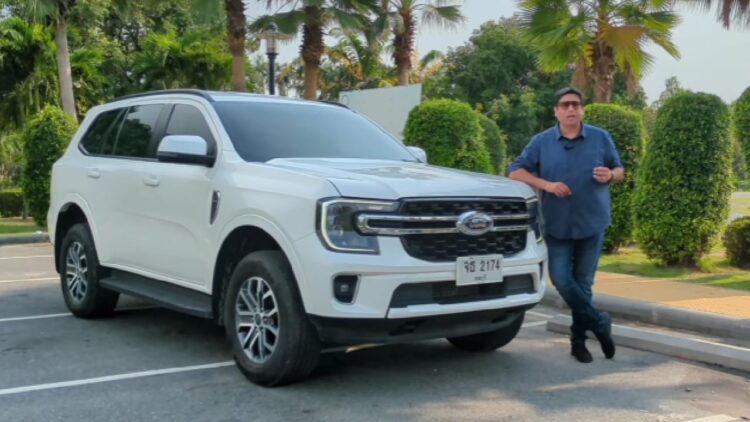A prominent Indian vlogger ends up testing the fuel efficiency of the base variant of the Ford Endeavour. There has been substantial buzz in the market regarding Ford’s comeback to India, particularly with the Endeavour (Everest) model. While it’s recognized as the Everest in international markets, here in India, it has always been known as the Endeavour. Consequently, it essentially remains the same vehicle for us. Moreover, given the patents Ford has recently filed in India, there’s a possibility that we’ll soon witness Everest making its way to our shores under the Endeavour badge. For the time being, let’s explore the details of this SUV from Thailand.
You may also like: After New Everest, Ford Ranger Seen at Chennai Port
Fuel Efficiency Test of Ford Endeavour
The video comes from Bunny Punia on YouTube. He has the Endeavour (Everest) with him for the day. In order to test the real-world mileage figure, he adopts the tank-to-tank method. As a result, he fills the tank at a petrol pump upto the auto-cut mark. Then, he takes the large SUV out on the road. In the initial part of this journey, he finds himself in the hustle and bustle of the city traffic. The roads are narrow and there are various cars around. But once he reaches the motorway, the situation gets favourable. He drives at highway speeds for the most part. But this trip was a great indication of what real-life driving looks like with a balance between city and highway runs.
You may also like: Ford Posts New Job Listings for Chennai Plant – Coincides with New Endeavour Sightings
During this test, he even performed an acceleration test. The SUV was able to complete the test run in around 9.87 seconds. That is quite impressive for a vehicle of this size. After a point, they made a U-turn to arrive at the fuel station. As is the case with every other fuel test, they measured the total distance travelled and divided it by the amount of fuel consumed. For a distance of 136.8 km, they filled 8.42 litres of fuel. This comes out to be an incredible 16.2 km/l.
You may also like: Ford Expanding Business in India, But It’s Not What You Think It’s For
Specs
The new Ford Everest offers several powertrain choices across different international markets. The one featured in this video by the vlogger is equipped with a 2.0-litre turbo diesel engine, delivering a respectable peak power of 170 PS. This engine is paired with a 6-speed automatic transmission. To potentially reduce expenses, the base trim might be available with a 4×2 configuration. We’ll need to wait and see if Ford introduces this variant for Indian customers.
You may also like: Ford India to Form JV with Tata Motors, Restart Operations with Hyundai Creta-Rival
Author’s Note
Recent Ford job postings and sightings of the Ranger and Endeavour in Chennai indicate that we may soon witness the American automaker’s reemergence in our market, after a hiatus of two and a half years since it halted car manufacturing here. With an existing Chennai plant capable of producing 150,000-200,000 cars and 350,000 engines annually, Ford’s return to the Indian market carries significant strategic importance. The company will undoubtedly be keen on addressing the challenges that previously resulted in substantial losses totalling $2 billion. This time, prioritizing profitability will be paramount. While there’s contemplation regarding the introduction of premium models like the new-generation Endeavour and the Mach-E, the primary emphasis will be on mainstream models such as the mid-size SUV to bolster its position in the country.
You may also like: BREAKING! Ford Starts Hiring for its ‘EV Revolution in India’
You may also like: Ford India to Restart Operations with a Maruti Grand Vitara-Rival, Patent Image Leaked
Disclaimer- The embedded videos/ external content is/are being used as a convenience and for informational purposes only; they do not constitute an endorsement or approval by Car Blog India of any of the products, services, and /or opinions of the corporation or organization or individual. Car Blog India bears no responsibility for the accuracy, legality, and/or content of the external site or for that of subsequent external videos/ external content. Contact the external publisher for answers to questions regarding its content.


